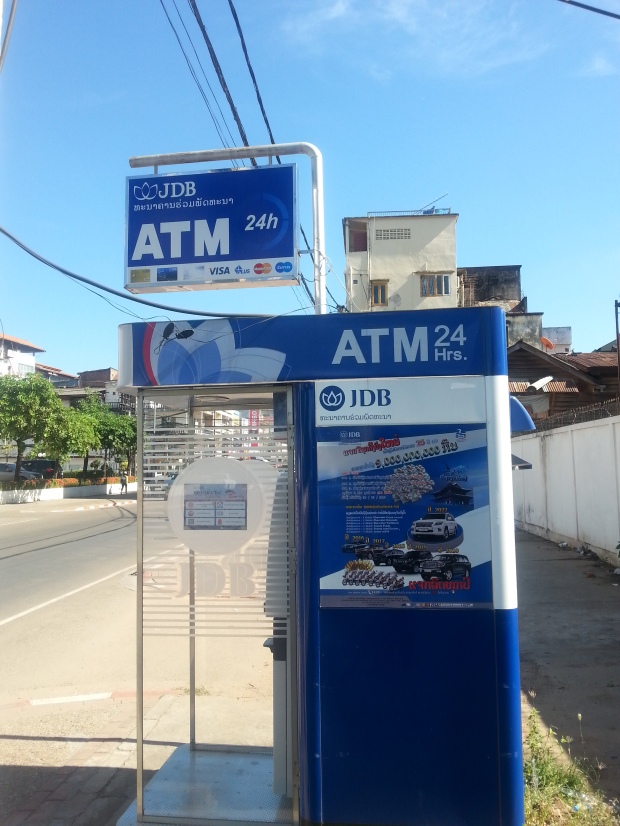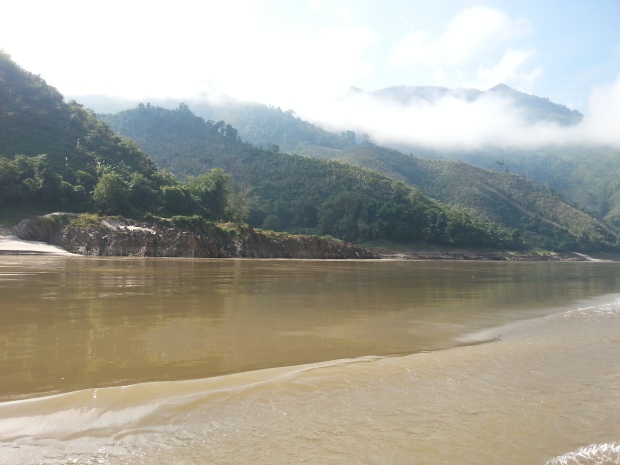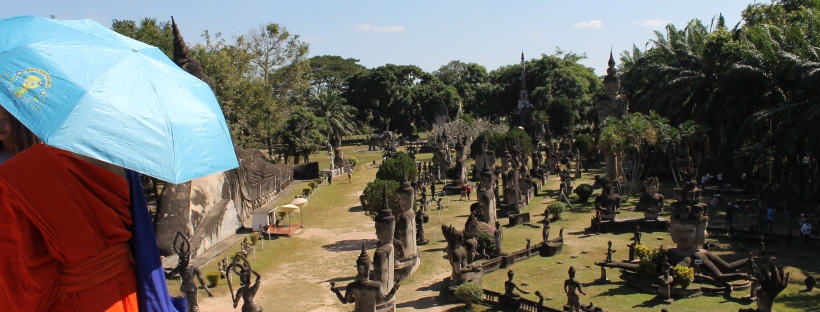I only spent 16 days in Laos so I am definitely not an expert on the country. This being said, during this time Dahn and I got to experience quite a bit of the country as we lived a more touristy life in Laos than in other countries. Instead of just always lazing about, we actually went out and explored the country. A part of it anyway. During this short time, here are some of things I noticed and think you guys might appreciate knowing about Laos.
- Traffic: Or the lack of it. There is very little traffic in Laos, if any. In Vientiane, the capital city, we walked around many times during rush hour and never saw more than 10 cars lined up at a light. This means the air is much cleaner than most of its neighbors and your life is not always in constant danger. Drivers here are very relaxed and will even let you cross the street before them. They will rarely go at high speeds in the city and in other cities then Vientiane, there are so few vehicles that you can often cross the street with your eyes closed (not recommended). This being said, highway driving is quite similar to other South-east Asian countries with dangerous speediing and passing.
- Horns: Or like #1, the lack of it. Laos’s streets are an amazing change to many of the other surrounding countries as they are very quiet. Car, bus, truck and motorcycle
horns are rarely used which makes walking down a busy street, a strangely silent and pleasant thing to do. You can speak and not scream in city centers and you also won’t get startled to death every few seconds, which is nice. - Transportation: Not so pleasant in Laos. VIP buses have a different meaning in Laos and Minivans drivers drive like they are high on cocaine. Local buses breakdown often and are quite beat up. To add to this problem, most roads are in bad condition. Especially the roads from Vientiane to Vang Vieng which are technically paved, paved like a slice of Swiss cheese. There are holes everywhere! Boats are a nice alternative as the ride is much smoother. However going up rivers like the the Mekong from Luang Prabang to Huay Xai can be quite slow as at times, the slow boats struggle to climb the rapids. The speedboats are much quicker but are not recommended due to safety issues. You will often see passengers wearing full face motorcycle helmets and pass you at blaring speeds! Sounds fun though right!?
- Nature: Laos has some of the most pristine nature in Asia. It is one of the countries with the most nationally protected areas (NPAs) in the world. NPAs Cover 14% of the land plus an additional 4% of provincially protected land makes Laos one of the premier destinations in the world for trekking, animal sightseeing, kayaking and other nature related activities. Laos also has a booming Eco-tourism market which helps support local people protect their land instead of destroying it. Many places hire ex-poachers or illegal loggers to show them that by protecting the land they can make more money than by destroying it. There are also 49 recognized different ethnic groups in Laos that live in remote villages. You can visit these villages through multi-day treks. Again with an Eco-tour agency which will help provide a better life to the villagers.
- Cost: The cost to travel in Laos is surprisingly expensive for such a poor country. Cost of meals, drinks, hotels, transportation and activities are quite expensive compared to its neighbors. A meal that would normally cost 3 $ CAD in Vietnam is easily 6-8 $ CAD in Laos. A good coffee in Vietnam was about 1.30 $ CAD compared to 4$ in Laos. Choices for accommodation are also limited compared to Vietnam or Thailand and tended to be more expensive for lower quality rooms.
- People: Laos has some of the friendliest people I met so far during my travels. They are so relaxed and pleasant to talk to. Nobody ever got verbally or physically angry with us. People often smile when you cross eyes. Rural kids and adults wave when you pass by and in cities they invite you to their noisy outdoor parties. Instead of looking at foreigners with disgust they look at us with curiosity. When a market deal falls through, they smile and go on with their life. Nobody is pushy and they were all very respectful. Laos is no longer the land of a million elephants unfortunately but at least, they can now be called the land of a million smiles.
- Food: What we had was very good, but with such a hard language to read, with little information online about local delicacies and city centers built only for tourists, it was very hard to find local dishes that we will long for. Those that did were often copies of those of Vietnam or Thailand. I am NOT saying that they do not have their own delicious specialties as I am sure they do. We just had difficulties finding them. Off the tip of my tongue, I could only mention Laap and Lao sausage. Don’t murder me please, I love Laos I swear! I need a food guide next time… 😦
- UXO: Laos has had a very difficult history and more recently, have been an innocent victim of the Vietnam War (“American” War). Even though they had signed a UN agreement that they were neutral in the war, this did not stop Vietnamese soldiers from building the Ho Chi Minh trail through Laos and the U.S. from bombing it. Neither did it stop the U.S. from building a secret rebel army that even used kids to fight against the Vietnamese. Or nor did it stop the Vietnamese of hiding in Laos and also creating rebel groups. All of this led Laos, a neutral country in the war, to become the most bombed country per capita in the history of mankind. Over 580 000 bombings occurred in Laos from 1965 to 1973 amounting to around 2.5 million tones of bombs. The equivalent of one bombing mission every eight minutes every day for 9 years straight (1). Thanks to an expected 80 million cluster munitions left lying around the country, over 100 casualties occur every year (2). Innocent children, women and men die every year due to these bombies. When you come to Laos, visiting one of the UXO information centers like COPE in Vientiane is a must. Consider donating at this link if you feel like you would like to help: Donate here
9. Safety: When visiting Laos, make sure that you have emergency evacuation covered in your insurance policy as there are no good hospitals in Laos. If ever you would need any special emergency care, being transported to Thailand as quickly as possible via helicopter is the wisest thing to do. If that is not possible, then Canadians should visit the Australian embassy clinic. Before coming to Laos, I always expected that if something happened to me, I would go to a decent hospital and get fixed but as I learned at COPE, many people die every year in Laos due to hospitals lacking resources. Some do not even have blood or oxygen to keep you alive… In Laos, always wear a helmet while on a motorbike, ride at low speeds, wear bug spray and don’t wonder off paths. Basically, take precautions!
10. Rural life: About 67% of Laos’s population lived in a rural setting in 2010. Meaning that to simply visit cities in Laos would be missing on the majority of the population. When in Laos, try to visit rural towns to see some incredible things and to build some memorable moments with the amazing local people and beautiful scenery. There is nothing more relaxing then looking onto limestone peaks with a clean flowing stream beside you from a bamboo hut build by local villagers.
This completes my list of 10 things to know about Laos. Now all that is left is for you to find yourself 2 – 4 weeks of free time, fly to a major city like Bangkok or Hanoi and ride a bus or take a flight into Laos! You will not regret it! Just bring plenty of sunscreen and insect repellent and you will have an amazing and very relaxing time.
Bonus tip: JDB bank seems to not charge any ATM fees. Unless they just secretly adding it in the transaction.
P.S. Did I mention that Laos is absolutely stunning?! I am currently writing this on a slowboat on the Mekong river going to Thailand and this is my view :
(1): http://www.maginternational.org/where-mag-works/laos/#.VpsoAPl94gt
(2): http://legaciesofwar.org/resources/books-documents/land-of-a-million-bombs/


































